A story of the Great Dravidian Architecture
|
Read. Imagine. Travel.
Namaste! India’s ancient temples are architectural marvels that portray the country’s rich past in terms of history, fascinating art and fantastic culture. Besides being examples of exquisite craftsmanship, the fact that these temples were built in an era when there was little or no mechanization adds to their mystique. In this edition, we will take you through another momentous journey narrating the story of the “Great Dravidian Architecture of India”.

The most famous temples in South India are the narrators of the tremendous Dravidian style of architecture. Marked by structures in stone, intricate inscriptions, tall towers, and life-like sculptures, these temples tell a thousand stories. Most of the temples differ in their design and style, as they represent different eras of various ruling dynasties. From early cave temples, which were carved out of sandstone hills, the architectural layout of South Indian temples evolved slowly to rock-cut temples and, finally, the standalone marvels that grew larger, both in terms of the area and height of the vimanas (main temple tower or structure over the inner sanctum). The beauty of Dravidian architecture, one of the three temple building styles in ancient India, is well documented, and acknowledged in the ancient book, Vastu Shastra (containing text on the traditional Indian system of architecture). Enjoy the beauty of magnificent Hampi that still resonates with the history of Vijayanagara Empire in this short video.
Interesting Fact: Angkor Wat, a Hindu-Buddhist temple is the largest religious monument in the world. This UNESCO listed Cambodian temple deploys the same circles and squares grid architecture as described in Indian Vāstu Śastras.
It is essential to understand the chronicles, so let us take a peek into the past to know the history and foundation of Dravidian Architecture.
Throughout Tamilakam (a geographical region inhabited by the ancient Tamil people and which today covers Tamil Nadu, Kerala, Puducherry, Lakshadweep, southern parts of Andhra Pradesh and Karnataka) a king was deemed divine by nature and possessed religious importance. Considered 'the representative’ of God on earth, the king was believed to live in a "koyil," - a "residence of God" or in a simple term, a "Temple". During a journey through Tamilakam, one will come across temples of different shapes and history. Some of these temples are rectangular, while a few are square, and some of these temples are star-shaped or octagonal. But there are some striking similarities in these Dravidian masterpieces of art as listed below:
■ All the temples generally have Gopurams, the large entrance towers. Being a representative of power, wealth, and prosperity, these Gopurams were always the tallest edifices of a town.
■ All the temples have Pitha (Altar), the most sacred place inside the temple. The Pitha includes the inner sanctum known as the Garbhagriha or God's sitting place. Many historians believe that before the temple's construction, the Kings used to organize a grand ceremony and were said to construct the inner sanctum first.
■ The inner sanctum is surrounded by small shrines, mandapas, and pillared corridors. Mandapa means any hall, roofed or open, which stood independently or united to the temple's sanctum. They are either the entryways or porches, which generally lead to the inner sanctum of the temple.
■ For devotees, there is a rectangular hall carefully constructed in front of the sanctum from where they can view and worship the main deity inside the temple.
■ The smaller shrines or subsidiary altars that houses other deities.
■ Pillared halls that were used for many purposes and are invariable accompaniments of the temple.
■ Some of these temples had a treasury, a kitchen, a storeroom, and a dining hall as well.
■ In the temple yard lays the flag post and a platform for offering food.
ANCIENT KINGDOMS THAT CONTRIBUTED TO THE EVOLUTION OF DRAVIDIAN ARCHITECTURE
–Sangam period (300BCE – 300CE)
Best example of Sangam Period: One of the best examples of the Sangam Era are the sculptures of art, nature, and deities found in the Meenakshi Amman Temple, Madurai, and inside the Srirangam Ranganathaswamy Temple, Tiruchirappalli.
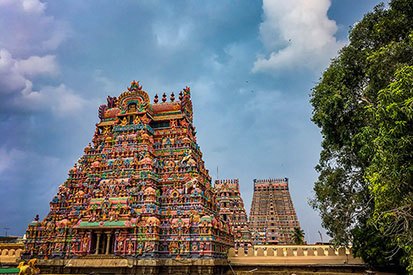
About Sangam Period: The most significant achievements of the early kingdoms of Chola, Chera, and the Pandyas were the inclusion of brick shrines for Gods such as Murugan, Shiva, and Amman (Mariamman, or Mother Mari), and Thirumal (Vishnu).
–The Badami Chalukyas (543 – 753 CE)
Best example of the Badami Chalukyas: One of the most well-known example are the rock-cut temples of Pattadakal and Aihole, a UNESCO World Heritage Site, located near Badami. The two most famous paintings seen in Ajanta cave no. 1, a UNESCO World Heritage Site, located near Aurangabad, "The Temptation of the Buddha" and "The Persian Embassy" are also attributed to this kingdom.
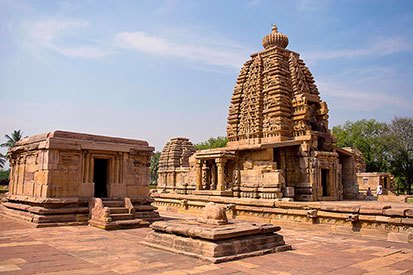
About The Badami Chalukyas dynasty: Known as the first Chalukyas, they ruled from Badami in Karnataka and spawned Vesara architecture (a hybrid temple architecture). The style was later coined as Badami Chalukya architecture.
|
– Rashtrakutas (753 – 973 CE)
Best example of Rashtrakutas marvels: They built some of the finest Dravidian monuments in the rock-cut architectural style which is truly reflected in 34 rock-cut shrines constructed by them. Elephanta Caves near Mumbai and rock-cut shrines in Ellora near Aurangabad, both UNESCO World Heritage Sites, are some of their best examples. The most admired among them all is the Kailasa temple located in Ellora. The temple is an excellent achievement of Dravidian art with walls depicting spectacular sculptures inspired by Hindu mythology.
 About the Rashtrakutas Dynasty: The Rashtrakuta Dynasty ruled some parts of South India from the 8th to the 10th century AD. At its zenith, their kingdom included the entire modern state of Karnataka, along with some parts of Tamil Nadu, Andhra Pradesh, Telangana, Maharashtra, and Gujarat.
About the Rashtrakutas Dynasty: The Rashtrakuta Dynasty ruled some parts of South India from the 8th to the 10th century AD. At its zenith, their kingdom included the entire modern state of Karnataka, along with some parts of Tamil Nadu, Andhra Pradesh, Telangana, Maharashtra, and Gujarat.
– Western Chalukyas (973 – 1180 CE)
Best example of Western Chalukyas: Some of the finest marvels commissioned by Western Chalukyas are the Kalleshwara temple at Bagali, Kasi Vishveshvara at Lakkundi, Mallikarjuna at Kuruvatii, and Mahadeva Temple at Itagi, all in the state of Karnataka.
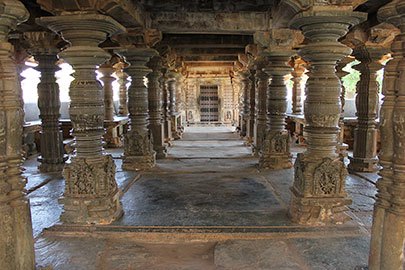 About Western Chalukyas Dynasty: The Western Chalukyas, also known as the Kalyani Chalukyas or Later Chalukyas, ruled Deccan India from their capital Kalyani (now called Basavakalyan in Bidar, Karnataka). They further perfected the Chalukyan style, coined as the Western Chalukya architecture. Over 50 temples along the Krishna River in Central Karnataka are attributed to this kingdom. Apart from temples, they were also known to ornate the step wells, which served as ritual bathing places. Many centuries later, the Hoysalas and the Vijayanagara Empire used these designs.
About Western Chalukyas Dynasty: The Western Chalukyas, also known as the Kalyani Chalukyas or Later Chalukyas, ruled Deccan India from their capital Kalyani (now called Basavakalyan in Bidar, Karnataka). They further perfected the Chalukyan style, coined as the Western Chalukya architecture. Over 50 temples along the Krishna River in Central Karnataka are attributed to this kingdom. Apart from temples, they were also known to ornate the step wells, which served as ritual bathing places. Many centuries later, the Hoysalas and the Vijayanagara Empire used these designs.
- Pallavas (600–900 CE)
Best example of Pallava marvels: The most significant accomplishment of the Pallavas are the single rock temples in Mahabalipuram and their capital Kanchipuram, Tamil Nadu. The finest examples among all the temples constructed by them are the majestic Kailasanatha temple in Kanchipuram and UNESCO listed Shore Temple in Mahabalipuram.
 About Pallava Dynasty: Pallavas were instrumental in the transition from rock-cut temples to stone temples. They ruled most of the area of the present state of Karnataka, along with Southern India. The kingdom included parts of Andhra Pradesh and northern Tamil Nadu. The origin of Pallavas is something that is always speculated by historians. Few claim that they were the former governors of the Satvahanas, while some claim they descended from the Cholas. Enjoy the magnificence of Mahabalipuram in this short video.
About Pallava Dynasty: Pallavas were instrumental in the transition from rock-cut temples to stone temples. They ruled most of the area of the present state of Karnataka, along with Southern India. The kingdom included parts of Andhra Pradesh and northern Tamil Nadu. The origin of Pallavas is something that is always speculated by historians. Few claim that they were the former governors of the Satvahanas, while some claim they descended from the Cholas. Enjoy the magnificence of Mahabalipuram in this short video.
– Pandyas (4th century BCE - 16th century CE)
Best example of Pandya marvels: The Srivilliputhur Andal Temple is the finest example of architecture built during the Pandya kingdom. The striking landmark is a 12-tiered tower structure dedicated to the Lord of Srivilliputhur, known as Vatapatrasayee. The tower is 192 feet (59 m) tall and was officially adopted by the Government of Tamil Nadu as the state symbol. The other most iconic temples commissioned by the Pandyas include the majestic Meenakshi temple in Madurai, Kalugumalai temple complex around 120 Kms from Madurai etc.
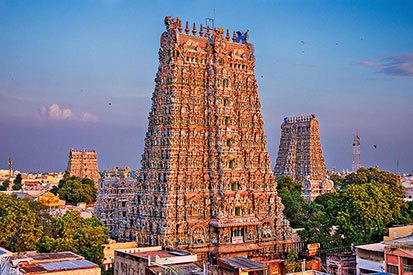 About The Pandya Dynasty: Pandyan kingdom was one of the three great South Indian kingdoms (the other 02 were the Cholas and Cheras). They ruled over parts of Tamil Nadu and Kerala until the sixteenth century. Initially their capital was Korkai, a seaport on India's southernmost tip. However, it was later moved to Koodal or Madurai. Their love for art and architecture reflect in various rock-cut and structural temples commissioned by them. While early Pandya temples feature Vimanas and Mandapas, the later temples of Pandyas were famous for sculptured idols and Gopurams.
About The Pandya Dynasty: Pandyan kingdom was one of the three great South Indian kingdoms (the other 02 were the Cholas and Cheras). They ruled over parts of Tamil Nadu and Kerala until the sixteenth century. Initially their capital was Korkai, a seaport on India's southernmost tip. However, it was later moved to Koodal or Madurai. Their love for art and architecture reflect in various rock-cut and structural temples commissioned by them. While early Pandya temples feature Vimanas and Mandapas, the later temples of Pandyas were famous for sculptured idols and Gopurams.
INTERESTING FACT: The Pandyas were best known for their trading network, which covered as far as Rome and Greece. They sent the first Indian ambassador to Rome in 26 BCE. The Pandyans gave a lot of emphasis to trading links with the Southeast Asian empires as well. They were famous for pearl fisheries and silk industry.
– Cholas (848–1280 AD)
Best example of Chola marvels: The Great Living Chola Temples, a UNESCO World Heritage Site including the Brihadeshvara Temple in Thanjavur, Brihadishvara Temple in Gangaikonda Cholapuram, and Airavatesvara Temple in Darasuram testify the brilliant achievements of the Chola Empire in architecture, sculpture, painting and bronze casting.

About Cholas Dynasty: Some of the biggest names of the Chola Kingdom are Rajaraja Chola I and Rajendra Chola, his son. Both of them were very religious and were responsible for building numerous temples worldwide. Starting from the first Chola King, Vijayalaya Chola, the Chola kings were prolific builders of temples. Vijayalaya Chola was the pioneer in building the eclectic chain of Vijayalaya Chozhisvaram temples near Narttamalai. His son Aditya I later built numerous temples in and around the Kanchi and Kumbakonam regions.
The Chola period was remarkable for sculpture making and bronze casting. These craftsmen were considered pioneers in exporting them all over the world. Though the sculptors generally adhered to the long traditional iconographic conventions, however in the 11th and 12th centuries, they worked with freedom to accomplish the classical grace and grandeur of the sculptures that we see today. The best example is the famous form of Nataraja, the Divine Dancer.
– Hoysalas (1100–1343 CE)
Best examples of Hoysala marvels: Chennakesava Temple in Belur, Hoysaleswara temple in Halebidu, and the Kesava Temple in Somanathapura are some of the finest examples of their style.
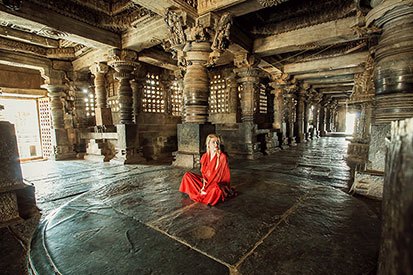
About the Hoysala Dynasty: The Hoysala kings ruled southern India from Belur and later shifted to Halebidu in Karnataka. They developed a unique architecture called Hoysala architecture, which is said to be an offshoot of the Western Chalukya style but showing unique Dravidian influences. It is described as Karnata Dravida and is separate from the traditional Dravida architecture. Witness the beauty of Hosyala Temples in this short video.
– Vijayanagara (1343–1565 CE)
Best example of Vijayanagara marvels: Nothing supersedes the huge open-air theatre of monuments at Vijayanagara, in Hampi, a UNESCO World Heritage Site.

About The Vijayanagara Empire: A vibrant combination of the Chalukya, Hoysala, Pandya, and Chola styles, Vijayanagara architecture is a hotspot of different styles prospered beautifully for centuries. Their legacy of sculpture, architecture, and painting influenced the development of art that came long after the empire ended. Their hallmark is the ornate pillared halls called Kalyanamantapa (marriage hall), Vasanthamantapa (open pillared halls), and the Rayagopura (a tower).
The Vijayanagara kingdom was always under a threat of invasion; this led to heavy usage of hard granite, which was locally available and was known for its durability. The fine work of the Vijayanagara kingdom is sprinkled across Southern India.
– Chera (02nd century BCE to 12th century CE.)
Best example of Chera marvels: The temples commissioned by them and made up of sandstone and granite can be observed in 04 parts, Vimana (structure over the inner sanctum), Mandapas (a porch-like structure through the gateway and leading to the temple), Gopuram (ornate gateway), and Garbagriha (the sanctum sanctorum).The Chera Style is one of its kind in Dravidian architecture. The Kumari Amman Temple, Kanyakumari, Kadambar Koil (Kalamboir Temple), lying close to Tiruchirappalli etc. are some of the best examples to describe Chera architecture.
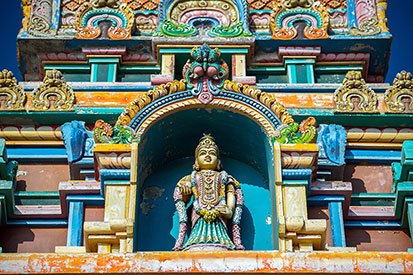
About Chera Dynasty: Cheras are considered to be one of the oldest Dravidian dynasty of Tamil origin who ruled many parts of Tamil Nadu and Kerala. Together with the Cholas and the Pandyas, they formed the three principle warring Iron Age kingdoms of South India, known as the “MOOVENDHAR: The Three Crowned Kings of Tamilakam”.
Exploring and admiring the Dravidian architecture in South India is as much a lesson in history as it is in architecture. Besides the stylistic influences of the architects of each era, who received royal patronage, the Dravidian architecture also depict the religious history of the region, the progression from early Buddhist influences to Hinduism, and the subsequent struggle for power between the Shaivite and Vaishnavite sects. The resulting grandeur are the splendid sights that has placed South Indian temples among the top architectural wonders of India. We, at Indo Asia Tours, are all about the handcrafted tours, memories, and moments you take out of your trip, and believe us, this escapade will be a life-changing one!
|
Virtual Destination Training Program
|
 Thank you, patrons, for reposing faith in our destinations and enquiring for customised virtual destination awareness training programs. We are proud to conduct them successfully so far and are looking forward to hold similar virtual destination awareness training programs for your team or yourself or a virtual tour for your clients. Let us know the destination of your interest along with your convenient date / time and we will be happy to set up a program for you.
Thank you, patrons, for reposing faith in our destinations and enquiring for customised virtual destination awareness training programs. We are proud to conduct them successfully so far and are looking forward to hold similar virtual destination awareness training programs for your team or yourself or a virtual tour for your clients. Let us know the destination of your interest along with your convenient date / time and we will be happy to set up a program for you.
Send Request
|
Please feel free to write back to us at marketing@indoasiatours.com to share our thoughts on customized journeys covering the Indian subcontinent or take time to visit our website https://www.indoasia-tours.com. Be sure we will prepare the best program to make a memorable trip for your esteemed clients!
|
|


 About Sangam Period: The most significant achievements of the early kingdoms of Chola, Chera, and the Pandyas were the inclusion of brick shrines for Gods such as Murugan, Shiva, and Amman (Mariamman, or Mother Mari), and Thirumal (Vishnu).
About Sangam Period: The most significant achievements of the early kingdoms of Chola, Chera, and the Pandyas were the inclusion of brick shrines for Gods such as Murugan, Shiva, and Amman (Mariamman, or Mother Mari), and Thirumal (Vishnu).
 About The Badami Chalukyas dynasty: Known as the first Chalukyas, they ruled from Badami in Karnataka and spawned Vesara architecture (a hybrid temple architecture). The style was later coined as Badami Chalukya architecture.
About The Badami Chalukyas dynasty: Known as the first Chalukyas, they ruled from Badami in Karnataka and spawned Vesara architecture (a hybrid temple architecture). The style was later coined as Badami Chalukya architecture.
 About the Rashtrakutas Dynasty: The Rashtrakuta Dynasty ruled some parts of South India from the 8th to the 10th century AD. At its zenith, their kingdom included the entire modern state of Karnataka, along with some parts of Tamil Nadu, Andhra Pradesh, Telangana, Maharashtra, and Gujarat.
About the Rashtrakutas Dynasty: The Rashtrakuta Dynasty ruled some parts of South India from the 8th to the 10th century AD. At its zenith, their kingdom included the entire modern state of Karnataka, along with some parts of Tamil Nadu, Andhra Pradesh, Telangana, Maharashtra, and Gujarat.
 About Western Chalukyas Dynasty: The Western Chalukyas, also known as the Kalyani Chalukyas or Later Chalukyas, ruled Deccan India from their capital Kalyani (now called Basavakalyan in Bidar, Karnataka). They further perfected the Chalukyan style, coined as the Western Chalukya architecture. Over 50 temples along the Krishna River in Central Karnataka are attributed to this kingdom. Apart from temples, they were also known to ornate the step wells, which served as ritual bathing places. Many centuries later, the Hoysalas and the Vijayanagara Empire used these designs.
About Western Chalukyas Dynasty: The Western Chalukyas, also known as the Kalyani Chalukyas or Later Chalukyas, ruled Deccan India from their capital Kalyani (now called Basavakalyan in Bidar, Karnataka). They further perfected the Chalukyan style, coined as the Western Chalukya architecture. Over 50 temples along the Krishna River in Central Karnataka are attributed to this kingdom. Apart from temples, they were also known to ornate the step wells, which served as ritual bathing places. Many centuries later, the Hoysalas and the Vijayanagara Empire used these designs.
 About Pallava Dynasty: Pallavas were instrumental in the transition from rock-cut temples to stone temples. They ruled most of the area of the present state of Karnataka, along with Southern India. The kingdom included parts of Andhra Pradesh and northern Tamil Nadu. The origin of Pallavas is something that is always speculated by historians. Few claim that they were the former governors of the Satvahanas, while some claim they descended from the Cholas.
About Pallava Dynasty: Pallavas were instrumental in the transition from rock-cut temples to stone temples. They ruled most of the area of the present state of Karnataka, along with Southern India. The kingdom included parts of Andhra Pradesh and northern Tamil Nadu. The origin of Pallavas is something that is always speculated by historians. Few claim that they were the former governors of the Satvahanas, while some claim they descended from the Cholas.  About The Pandya Dynasty: Pandyan kingdom was one of the three great South Indian kingdoms (the other 02 were the Cholas and Cheras). They ruled over parts of Tamil Nadu and Kerala until the sixteenth century. Initially their capital was Korkai, a seaport on India's southernmost tip. However, it was later moved to Koodal or Madurai. Their love for art and architecture reflect in various rock-cut and structural temples commissioned by them. While early Pandya temples feature Vimanas and Mandapas, the later temples of Pandyas were famous for sculptured idols and Gopurams.
About The Pandya Dynasty: Pandyan kingdom was one of the three great South Indian kingdoms (the other 02 were the Cholas and Cheras). They ruled over parts of Tamil Nadu and Kerala until the sixteenth century. Initially their capital was Korkai, a seaport on India's southernmost tip. However, it was later moved to Koodal or Madurai. Their love for art and architecture reflect in various rock-cut and structural temples commissioned by them. While early Pandya temples feature Vimanas and Mandapas, the later temples of Pandyas were famous for sculptured idols and Gopurams.
 About Cholas Dynasty: Some of the biggest names of the Chola Kingdom are Rajaraja Chola I and Rajendra Chola, his son. Both of them were very religious and were responsible for building numerous temples worldwide. Starting from the first Chola King, Vijayalaya Chola, the Chola kings were prolific builders of temples. Vijayalaya Chola was the pioneer in building the eclectic chain of Vijayalaya Chozhisvaram temples near Narttamalai. His son Aditya I later built numerous temples in and around the Kanchi and Kumbakonam regions.
About Cholas Dynasty: Some of the biggest names of the Chola Kingdom are Rajaraja Chola I and Rajendra Chola, his son. Both of them were very religious and were responsible for building numerous temples worldwide. Starting from the first Chola King, Vijayalaya Chola, the Chola kings were prolific builders of temples. Vijayalaya Chola was the pioneer in building the eclectic chain of Vijayalaya Chozhisvaram temples near Narttamalai. His son Aditya I later built numerous temples in and around the Kanchi and Kumbakonam regions.
 About the Hoysala Dynasty: The Hoysala kings ruled southern India from Belur and later shifted to Halebidu in Karnataka. They developed a unique architecture called Hoysala architecture, which is said to be an offshoot of the Western Chalukya style but showing unique Dravidian influences. It is described as Karnata Dravida and is separate from the traditional Dravida architecture.
About the Hoysala Dynasty: The Hoysala kings ruled southern India from Belur and later shifted to Halebidu in Karnataka. They developed a unique architecture called Hoysala architecture, which is said to be an offshoot of the Western Chalukya style but showing unique Dravidian influences. It is described as Karnata Dravida and is separate from the traditional Dravida architecture.  About The Vijayanagara Empire: A vibrant combination of the Chalukya, Hoysala, Pandya, and Chola styles, Vijayanagara architecture is a hotspot of different styles prospered beautifully for centuries. Their legacy of sculpture, architecture, and painting influenced the development of art that came long after the empire ended. Their hallmark is the ornate pillared halls called Kalyanamantapa (marriage hall), Vasanthamantapa (open pillared halls), and the Rayagopura (a tower).
About The Vijayanagara Empire: A vibrant combination of the Chalukya, Hoysala, Pandya, and Chola styles, Vijayanagara architecture is a hotspot of different styles prospered beautifully for centuries. Their legacy of sculpture, architecture, and painting influenced the development of art that came long after the empire ended. Their hallmark is the ornate pillared halls called Kalyanamantapa (marriage hall), Vasanthamantapa (open pillared halls), and the Rayagopura (a tower).
 About Chera Dynasty: Cheras are considered to be one of the oldest Dravidian dynasty of Tamil origin who ruled many parts of Tamil Nadu and Kerala. Together with the Cholas and the Pandyas, they formed the three principle warring Iron Age kingdoms of South India, known as the “MOOVENDHAR: The Three Crowned Kings of Tamilakam”.
About Chera Dynasty: Cheras are considered to be one of the oldest Dravidian dynasty of Tamil origin who ruled many parts of Tamil Nadu and Kerala. Together with the Cholas and the Pandyas, they formed the three principle warring Iron Age kingdoms of South India, known as the “MOOVENDHAR: The Three Crowned Kings of Tamilakam”.
 Thank you, patrons, for reposing faith in our destinations and enquiring for customised virtual destination awareness training programs. We are proud to conduct them successfully so far and are looking forward to hold similar virtual destination awareness training programs for your team or yourself or a virtual tour for your clients. Let us know the destination of your interest along with your convenient date / time and we will be happy to set up a program for you.
Thank you, patrons, for reposing faith in our destinations and enquiring for customised virtual destination awareness training programs. We are proud to conduct them successfully so far and are looking forward to hold similar virtual destination awareness training programs for your team or yourself or a virtual tour for your clients. Let us know the destination of your interest along with your convenient date / time and we will be happy to set up a program for you.






